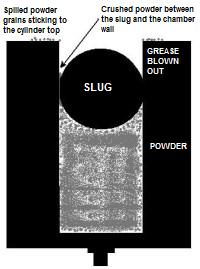Howdy
I suppose I should chime in on this one. I don't shoot much C&B these days, but I bought my first C&B revolver in 1968.
Lubricated wads were not on the market then. In those days it was standard procedure to smear Crisco over the ball. I was never crazy about the idea of Crisco, the grease in the chamber next to the one being fired would melt and run out of the chamber. Regarding chain fires, if you don't get a good seal with the ball, if for instance there happens to be a dent or cut in the ball right where it seals in the chamber, that will leave an open path for an errant spark to find its way to the powder in an adjacent chamber.
Yes, I had a chain fire once back then, slathering Crisco over the balls. As I said, I never felt that a thin layer of melted grease offered much spark protection in case there was a void in the ball to cylinder seal. Once Wonder Wads became available I never slathered anything over the balls again. 1/8" or so of felt makes a better spark arrester than a few thousandths of contact between the ball and the chamber.
On the rare occasion I shoot a C&B these days, I always place a Wonder Wad between the powder and ball, and nothing on top of the ball.

